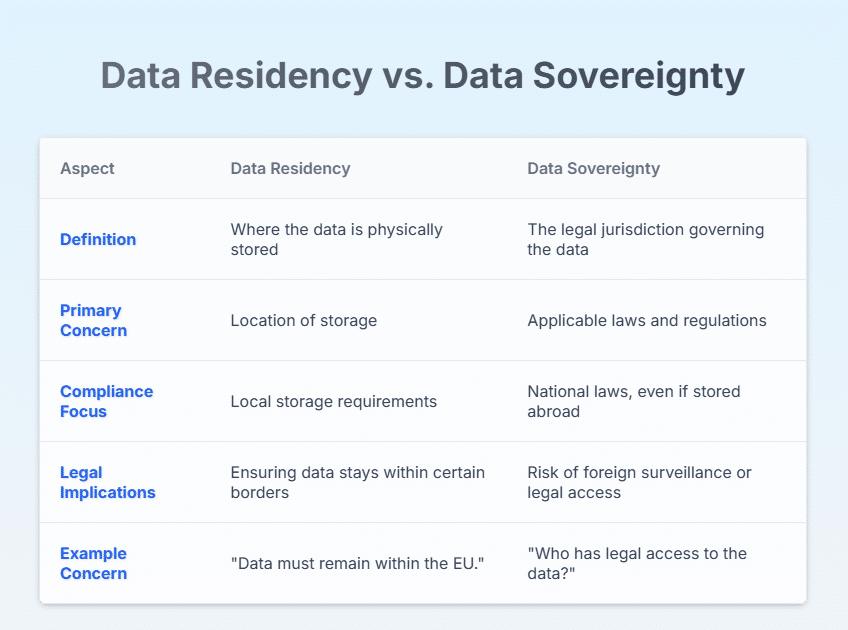Decoding Data Residency and Data Sovereignty for Global Compliance
Startups

As data becomes the foundation of global operations, regulatory and compliance problems emerge, including where and how it is stored and accessed. Data residency and data sovereignty are two main requirements defining the regulatory landscape. While the terms are frequently used interchangeably, they represent separate legal and practical concepts.
What is data residency?
Data residency, quite literally, refers to the physical or geographic place where data lives. Certain types of data, particularly sensitive or personal information, may be required by governments and authorities to be stored in specific locations or to stay inside national boundaries.
This requirement is frequently observed in industries where sensitive data may be subject to stringent storage rules, such as healthcare, finance, or government services. The goals of data residency legislation are to safeguard national interests, improve data security, and make regulatory supervision simpler.
Beyond the legal requirements, data residency also addresses practical concerns about access, latency, and disaster recovery. Having data physically closer to its users can improve performance and reliability. Also, maintaining your data across several different geographic locations makes your systems more resilient.
What is data sovereignty?
In contrast, data sovereignty refers to a broader legal term. It means that data is bound by the rules and government of the country where it is physically located. So, if a corporation maintains its data in a different country from where the owner resides, the data is subject to the laws of that country.
This approach has the potential to cause legal issues, particularly when data housed in one nation is subject to privacy rules in another. For example, the US CLOUD Act empowers American law enforcement to obtain data from US-based corporations, even if the data is kept elsewhere.
This could raise compliance and privacy problems for non-U.S. entities. For example, a multinational organization might have to appease contradictory legal requirements across different territories. Companies could find themselves caught between competing obligations, where complying with one nation’s data access demands could constitute a violation of another country’s data protection laws.
Why data regulations are becoming stricter
Due to the increase in data breaches and cross-border data flows, many nations are tightening data storage and access regulations. You could face huge fines, harm to your organization’s reputation, or interruptions in business operations as the repercussions of non-compliance.
Here are some of the main factors behind these requirements:
- National security: Countries want to protect critical infrastructure and sensitive citizen data from foreign surveillance. The increasing sophistication of cyberattacks and espionage further intensifies these concerns.
- Data privacy regulations: Laws such as the EU’s GDPR, Canada’s PIPEDA, and China’s PIPL demand strict data governance. These regulations often include specific requirements around data storage, processing, and transfer.
- Digital sovereignty movements: Governments are pushing for autonomy over digital infrastructures, including cloud services. This drive aims to ensure that data and digital assets remain under their jurisdiction and control.
- Legal conflicts: Different countries have contradictory regulations, increasing legal complexity for multinational businesses. This creates significant operational challenges in managing data and delivering services consistently across borders.

An overview of data residency regulations by region
Understanding regional requirements is crucial for compliance. Here are a few typical examples:
- European Union (GDPR): Requires that personal data of EU citizens be handled with strict privacy controls. While not mandating local storage, GDPR restricts data transfers to non-compliant jurisdictions.
- Australia (Privacy Act – Notifiable data breaches scheme): Though flexible on residency, Australia enforces strong accountability for cross-border data flows.
- China (PIPL – CSL): Requires critical data and personal information collected in China to be stored locally, with cross-border transfers subject to stringent assessments.
- Russia (Federal law No. 242-FZ): Requires that personal data of Russian citizens be stored in Russia.
- India (DPDP Act): Emphasizes consent and includes provisions that can restrict data transfers outside the country, especially to non-whitelisted nations.
Best practices for global data compliance
If you’re doing business globally, you deal with a variety of different rules about where data needs to live and who can access it. You’ll need a strategy that brings together tech solutions, legal know-how, and company policies. Here are some proven methods for managing your data across different regions.
1. Deploy on local cloud servers
Choosing a cloud service provider with a strong global presence is a fundamental step in addressing data residency requirements. Opt for a provider that offers multi-region data center options, allowing you to store data within specific geographic boundaries. This not only helps comply with local regulations but also enhances performance by reducing latency for users in those regions.
Ensure your provider offers:
- Regional failover options: Redundancy is crucial for business continuity. Your provider should offer failover capabilities that allow you to seamlessly switch to a secondary data center within the same region in case of an outage
- Data encryption at rest and in transit: Protecting data both while stored and during transmission is paramount. Your CSP should employ robust encryption methods, including encryption at rest (e.g., using AES-256) and encryption in transit (e.g., using TLS 1.2 or later), to safeguard data confidentiality and integrity.
- Localized data backups: Regular backups are essential for data recovery and disaster recovery. Your provider should offer the ability to store backups within the same region as the primary data, aligning with data residency requirements and minimizing data transfer costs.
2. Adopt data localization strategies
It’s important to have tech policies in place that keep data within specific regions. This means taking a hands-on approach to setting up your systems and apps, so data is handled according to the local rules. Here’s a closer look at key aspects of this strategy:
- Configuring storage endpoints to restrict geographic zones
- Using local key management services (KMS)
- Implementing access controls based on user location
3. Conduct data mapping and classification
You can’t protect or localize what you don’t know. Conducting regular audits is essential, and this process begins with understanding your landscape and how to protect your cloud databases.
- Identify where your data resides
- Classify sensitive vs. non-sensitive data
- Understand data flow across borders
4. Implement strong encryption and access controls
Use end-to-end encryption and role-based access to protect databases, regardless of location. Even if data crosses borders, encryption can render it inaccessible without the appropriate keys.
Consider:
- Bring your own key (BYOK)
- Customer managed keys (CMK)
- Hardware security modules (HSMs)
- Cloud firewall solutions like OPNsense or Fortigate
5. Establish cross-border data transfer mechanisms
For data transfers, use legal safeguards such as:
- Standard contractual clauses (SCCs): For EU to non-EU transfers
- Binding corporate rules (BCRs): For multinational companies
- Data transfer impact assessments (DTIAs): To evaluate risk
6. Monitor regulatory developments
Stay informed on changes in global data laws. Assign legal and compliance teams to track emerging rules and assess their impact on business operations. Establish regular cross-functional meetings between IT, legal, and business units to ensure technical implementations align with evolving cloud compliance requirements.
7. Cooperate with local authorities
In sensitive regions, proactively engage with regulators to ensure transparency and build trust. This can smooth approval for cross-border transfers and help mitigate penalties.
Global data compliance challenges
Despite careful planning and implementation, organizations often encounter persistent challenges when managing data across global boundaries. Here are some of the key obstacles that require ongoing attention and resources:
- Inconsistent global laws: Conflicting laws between countries make compliance tricky.
- Operational costs: Setting up regional infrastructure is expensive and complex.
- Cloud complexity: Multicloud and hybrid setups add layers of management difficulty.
- Data fragmentation: Residency requirements may split data into silos, impacting analytics and global collaboration.
Addressing these challenges requires continuous investment and strategic adaptation.
Future-proofing your data strategy in a borderless world
There is increasing pressure on businesses to reconsider how they design their digital services as more governments impose localization requirements. Build trust with customers and authorities by baking data protection into your global operations from the start.
Data residency and sovereignty will play an ever bigger role in corporate strategy in the upcoming years. You need to reconcile operational effectiveness with regulatory compliance. Technologies like autonomous cloud architectures, privacy-preserving AI, and secret computing will be crucial.


